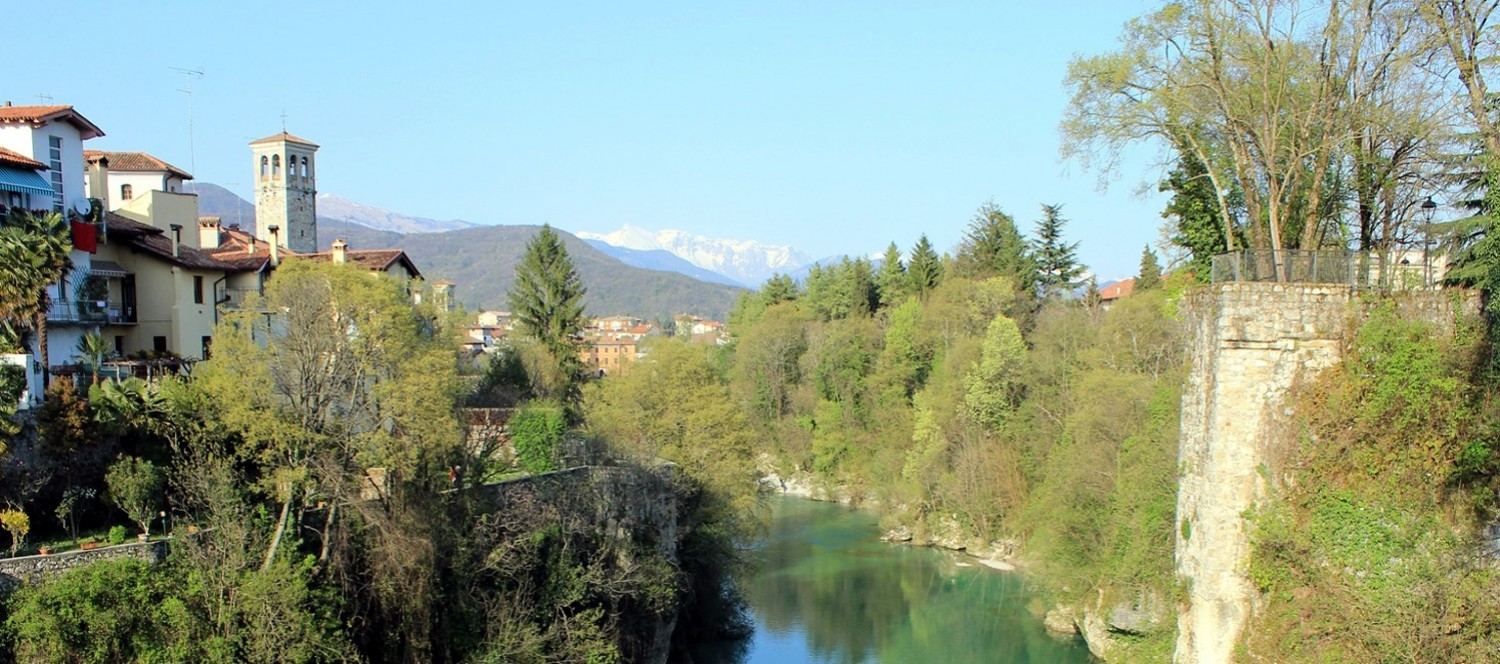
Italy into Slovenia
Italy & Slovenia in One Tour
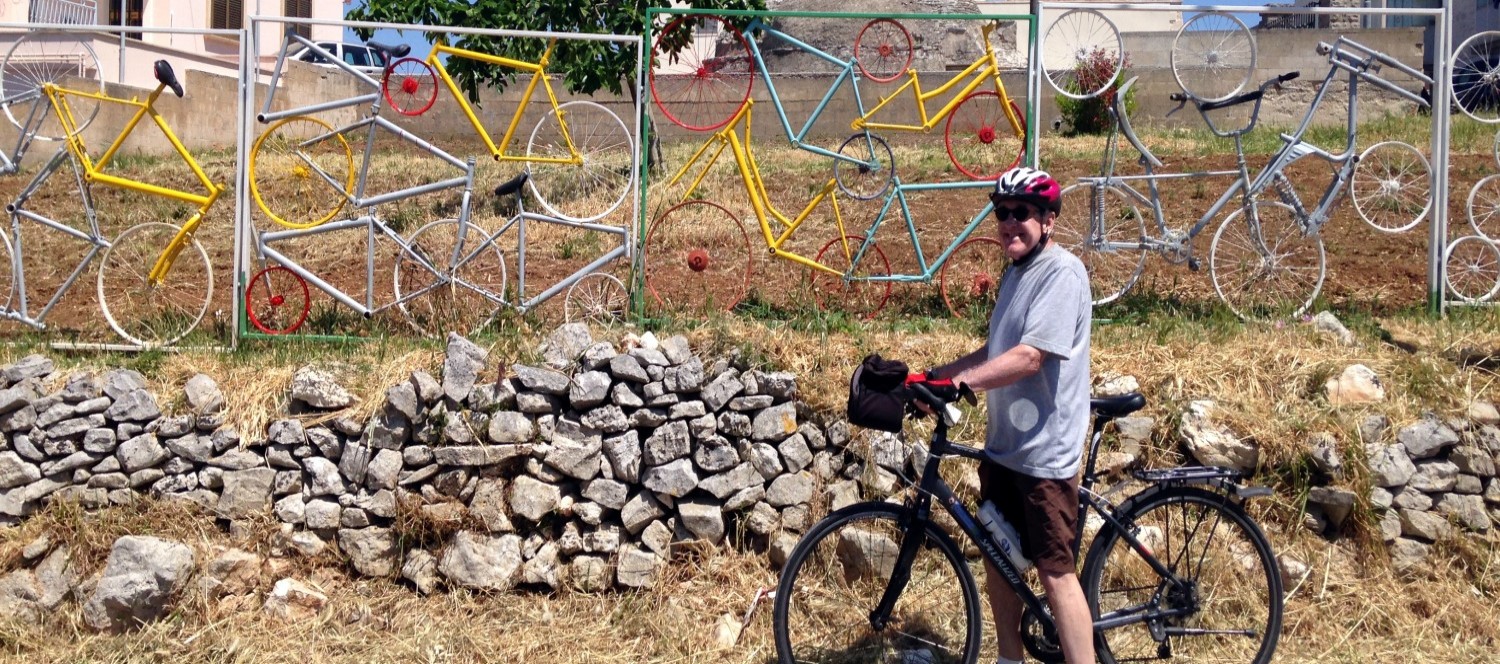
Italy & Slovenia Biking Tour
"Cycle from Friuli-Venezia-Giulia into Slovenia"
Visit the historic Villas, tour its vineyards and sample the San Daniele Prosciutto of Italy's Friuli region before crossing the border. Then visit Europe's largest underground grotto before gliding down the Adriatic Coast to Trieste. The Julian Alps serve as your backdrop as you bicycle along its vineyards and castle-laden foothills into Slovenia and stay in its capital, Ljubljana, before returning to the pristine Italian Coast...simply unforgettable.
Day 1: San Daniele Prosciutto - An Italian Delicacy
Ride within the Friuli-Venezia-Giulia, a tiny region in northeast Italy. As stunning region seldom seen by tourists. Tour Villa Manin site where Napoleon once resided. Then cycle a castle-laden countryside before arriving in San Daniele, home of Italy's finest prosciutto.
Day 2 & 3: Castles, Wineries & Countryside Abbeys
With the mighty Alps as your backdrop we cycle along the gentle hills covered in castles, vineyards, fruit trees and tiny hamlets. Explore the medieval streets of the region's wine capital, Cividale and relax at your 4-star hotel spa. Wine tasting and a fascinating Abbey visit highlight your third day's ride.
Day 4 & 5: Biking into Slovenia
We ride from our hotel down a quiet road that leads to the Slovenian border. Quickly we realize we aren't in Italy anymore. Green dominants the landscape, as lush forests cover more than half of the country. The architecture of its palaces, castles and manor houses stand out as truly distinct. A city tour of the capital Ljubljana makes it all clear then enjoy a wonderful 2 day stay in this exquisite medieval city.
Day 6: Postojna Grotto & Stunning Trieste
Tour Postojna Cave, Europe's largest underground grotto, and a UNESCO site. So large a train takes you through this natural wonder. Then cycle back into Italy via the Adriatic Coast passing impressive Castle Miramare before entering the picturesque waterfront of Trieste.
Day 7: .... Departure day
Inclusions
Not included
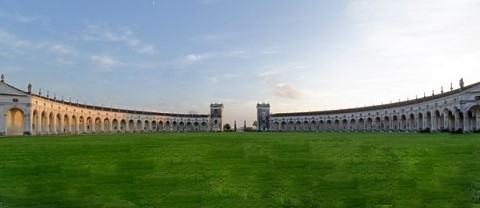
Italy & Slovenia Biking Tour
"Cycle from Friuli-Venezia-Giulia into Slovenia"
Friuli-Venezia-Giulia is one of the oldest inhabited Italian regions; it is believed that the first humans here dated back to as many as 20,000 years ago. It is now an autonomous region of north-eastern Italy, bordering Austria and Slovenia, and a crossroads of the Latin, German and Slavic cultures. In the North there are the Alps, while the territory along the coasts is mostly plain. Between Trieste and the Alps there is a wide, Karst plateau, the Carso, an important battlefield in WWI, where innumerable Italian and Austrian soldiers lost their lives.
Slovenia on the other hand is a tiny country with a very diverse nature, about half the size of Switzerland, and counts just over two million people. It was on 25 June 1991 that Slovenia declared independence from Yugoslavia and even though it does not have a majestic history like many larger European nations; the past is nevertheless important. For many it is surprising that such a small nation, without kings or famous military leaders of its own, could even form, survive and carve out an independent path. But this is the result of the resilience and determination of the Slovene people, whose culture and common language have survived for centuries in this green piece of Europe.
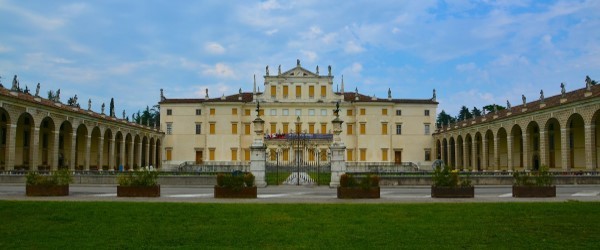
Today we meet in Codroipo and if you haven’t heard of it you are not alone, as I never had either, but I could see from first glance this is where it would best serve us to start our ride as well as our first excursion. The majestic ensemble of Villa Manin, seen above, is located in Passariano under the municipality of Codroipo. It is one of the most important artistic monuments in Friuli-Venezia-Giulia and one of the most popular symbols of the area. Commissioned in the 17th century by Ludovico Manin to celebrate the wealth and power of the Manin family; it was the family’s country house. The life of this majestic complex in Passariano has always been closely linked to the local historical and political events: at the end of the 18th century, under the reign of the last Doge of Venice Ludovico Manin (1789-1898), Napoleon Bonaparte chose this regal residence as the General Headquarters of the French troops who were stationed here in 1797 during the Italian campaign. The new order Napoleon was later to impose on the whole of Europe was planned here.
After a tour we start our ride back through Codroipo and crisscross the countryside passing through several tiny hamlets and the castle at River d'Arcano which maintains more of its early medieval structure than most Friulian castles and has an oval plan with 3 rings of walls. Then arrive at the capital of what many consider Italy’s finest prosciutto and the capital of Friulian language, San Daniele
Commonly associated with Tuscany and Emilia, the most renowned and expensive legs of prosciutto come from Central and Northern Italy, such as those of Parma, and San Daniele. It is also well known in Croatia, parts of Western Slovenia and Montenegro where it is known as pršut. The modern Italian word prosciugare, means "to thoroughly dry". Prosciutto comes from either pig's leg or from a wild horse's thigh. The process of making prosciutto can take anywhere from nine months to two years, depending on the size of the ham. We will visit a local producer and then enjoy a welcome meal offering, well, prosciutto of course.
Lodging: 3-star Albergo in the medieval center.
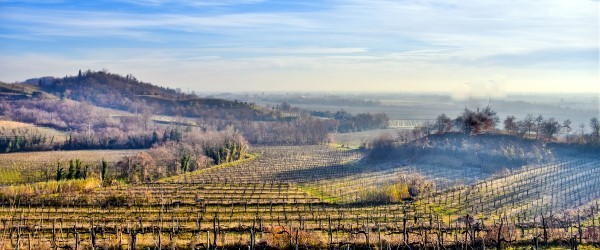
Day two’s ride takes us past the many castles of the region en route to the renowned capital of the Friuli wine region, Cividale dei Friuli. We will pass by several medieval castles and vineyards along the lowlands of Friuli, and a multitude of fortresses along the hills where it was once possible to control the enemies' arrival and communicate thanks to smoke signals and secret tunnels. Nowadays, these castles continue to sweep infinite landscapes and serve more as protectors of enchanted villages and corners where time seems to have stopped. All the castles of Friuli-Venezia-Giulia are linked in to pleasant itinerary named "The ham and castles' roads".
Our destination of Cividale del Friuli was named a UNESCO World Heritage Site in June 2011 as a key historical site under the title “The Lombards in Italy, the places of power (568-774 A.D.)” Cividale is also well known for its top wines, great food (Gubana is a delicious specialty - a type of strudel with apples, pine seeds and raisins - that you should not miss!) and close position to the finest wine cellars of the region!
We arrive early enough to enjoy the magnificent facilities of our 4 –star hotel. Hotel Castello offers us 2 jacuzzis, steam room, sauna and pool. For those that wish, massages are available at a reasonable fee.
Lodging: Beautiful 4-star converted castle with wellness center and outstanding views. For those that wish, massages are available at a reasonable fee.
Surrounding Cividale is a landscape that linger from the steps and terraces that rise above the woods to touch the sky before drifting back down to where the vine filled rows dominate the view.
Today we explore the wine producing area near Cividale where the hills ripple sinuously a mere breath away from the border with Slovenia. This area is pre-Alpine where most of the vineyards are located on hillside terrain. As in times past, with the hills elevation from 130 – 180 meters above sea level, the grape harvest is carried out by hand, bunch by bunch. You are sure to enjoy a private winery tour and picnic lunch of products produced from around the region.
Our day’s second destination is the Abbazia d’ Rosazzo, located on the eastern north-east of Manzano (District Chair), and about 10km from the border with Slovenia. The ancient Abbey, whose origins are not yet completely understood, mainly because of its geographical position as the connection point between east and west, where different cultures would meet and talk. This atmosphere of serene spirituality attracted a growing number of faithful; the cells multiplied so much that the oratory became a monastery. In 1823 the Abbey became the summer residence of the Bishops of Udine, whereby the Udine Bishop was awarded the noble title of Marquis of Rosazzo, a title which was later also recognized in 1927 by the Kingdom of Italy. The rebirth of Rosazzo started with a restoration after the earthquake of 1976. Then the spiritual rebirth was inspired by the 'Project Rosazzo', which started on October 1, 1994. Now the 'Monastery of the Rose' serves as a culture, humanities and social meeting place where they organize conferences, seminars, exhibitions, and debates.
About the Wines: Though the wines produced in this region represent only two percent of the Italy's production, to some they are comparable in quality to wine produced in Piedmont and Tuscany, the two most celebrated wine producing regions of Italy. The main difference between the regions is that Friuli-Venezia-Giulia wines are mostly white, though some exceptional red can be found as well.
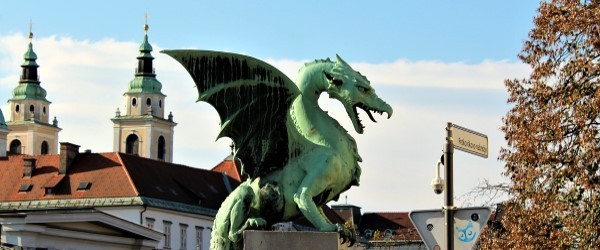
Today we bid adieu to Cividale, and briefly to Italy, as we cycle into Slovenia within some of Europe’s most magnificent landscapes. Our ride winds through the tiny quaint villages that skirt the Italian border such as Kobarid. We take time to explore the medieval center where one immediately can’t help notice a distinct contrast to our previous days in Italy. As we leave town we cross over the impressive Napolean Bridge spanning the rivers left and right banks where the gorge is narrowest. First built in ancient times it survived until 1616 when the Venetians demolished the wooden structure. The old Napoleon Bridge with a single made of stone was built in 1750. Napoleon's troops marched across it on the way to Predel Pass, hence its name. During World War I, it was blown up by Austrian soldiers, and later the Italians built a wooden and then an iron bridge. During World War II, the Partisans defended the Kobarid Republic here, and in memory of these events, two monuments have been placed beside the bridge. Our ride continues down the Soca & then Idrija River though several small rural villages. At the end of our ride we all board a train from this remote region of Slovenia for the fascinating capital Ljubljana.
Besides having the relaxed atmosphere of a small city, this picturesque and very vibrant capital is full of surprises. The town is noted for its traditional hospitality, diverse nature, city castle, top notch university, quality traditional restaurants and churches with their rich artistic legacy. On this free day some may wish to take the short train ride to Bled. Here an emerald-green lake, picture-most popular resort and its biggest tourist money-spinner. Not surprisingly, it can be overpriced and swarming with tourists. But as is the case with many popular destinations around the world, people come in droves – and will continue to do so – because the place is special. On a clear day you can make out Mt Stol (2236m) and Slovenia’s highest peak, Mt Triglav (2864m), in the distance – and then the bells start ringing from the belfry of the little island church. It’s quite simply magical.
A short background on Slovenia: It's a tiny country, about half the size of Switzerland, and counts just over two million people. But the only way to describe pint-sized Slovenia, an independent republic bordering Italy, Austria, Hungary, Croatia and the Adriatic Sea, is that it's 'a mouse that roars'. The Republic of Slovenia lies at the heart of Europe, where the Alps and the Mediterranean meet the Pannonian plains and the mysterious Karst. Green is the dominant color. There are many woods and forests in Slovenia – covering more than half of the country – and numerous preserved and protected plant and animal species. Mountains, lakes, waterfalls, forests, caves, hills, plains, rivers and the sea - you name it, as well as many natural and landscape parks. The country is also known for its great wines and delicious traditional food. The history of the Slovenian nation is stirring and often steeped in tremendous pride. Slovenian history started when our Slavic ancestors came from behind the Carpathi Mountains and proclaimed the principality of Carantania in the 7th century. Historians believe it was one of the most democratic and modern states at that point in history. In 1918 the Austro-Hungarian Empire was defeated and developed into the creation of the Kingdom of Serbs, Croats and Slovenes, renamed the Kingdom of Yugoslavia in 1929. In 1941-1945, was the dismemberment of Yugoslavia by the Axis Powers and in 1945 the formation of the Federal People`s Republic of Yugoslavia was created, with the People`s Republic of Slovenia as one of its 6 federal entities. It was on 25 June 1991 that Slovenia declared independence from Yugoslavia.
Lodging: 2 nights in a very nice 3-star located in the medieval center
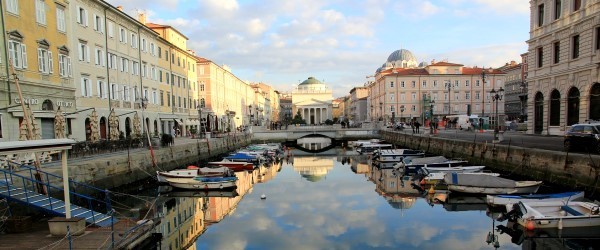
We depart Slovenia, but first stop near the border to visit Europe’s largest cave network. The Postojna Cave is a 20-km long karst cave system, a web of underground passages, galleries and chambers. It is the largest cave of the Classical Karst formations in Europe and has been visited by over 33 million people. The most interesting passages were discovered in 1818 by Luka Čeč. Prior to that, the visitors had only been able to access the passages not far from the entrance, where signatures of visitors to the cave have been recorded since the 13th century onwards. In 1872, railway tracks were laid in the cave and in 1884 electricity was installed. After this visit we do a short transfer for a countryside ride that leads through many tiny hamlets before dropping down to the coast where we cruise down along the Adriatic into Trieste.
Trieste has unfairly been neglected by the guidebooks and travel magazines, but this year it may finally receive some deserved recognition as it stages the final days of the important Giro d’ Italia bicycle race. This Adriatic jewel is one of my favorite ports in all of Italy offering a fascinating mix of architectural styles, wide promenades, and innumerable outdoor cafes where the Adriatic Sea always seems to be in view. Situated in the extreme northern part of the Mediterranean Sea along a very shallow bay of the Adriatic Sea it is part of the Gulf of Venice that is shared by Italy, Croatia and Slovenia. The entire Slovenian sea is part of the Gulf of Trieste.
Along the way we stop at the incomparable Castle Miramare. Considered a “must see” by many if visiting Trieste, the charming Castello di Miramare has become the most famous place along its coast. It was built between 1856 and 1860, on a design by Carlo Junken by order of Archduke Maximilian of Austria, later crowned Emperor of Mexico, who together with his wife Charlotte, wanted it to be built. The building, influenced by the Romantic style, is a sort of revisited medieval fortress with a wide park including rare plants, sculptures and small lakes. The castle became a state museum in 1955. We should arrive early enough to get a good look at the center of town and its waterfront.
Lodging: Wonderful 4**** hotel in the center of town near the waterfront.
If you are not staying in Venice please inquire about information to and from the tour start or to your onward travel locations. Train departure times and tracks are subject to change, so verify before boarding and remember to stamp your ticket.
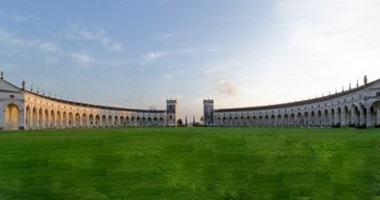
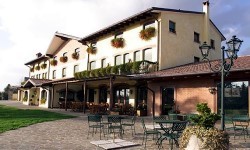
Hotel Picaron is situated above the town of San Daniele in all its splendor a commands wonderful views. This former hunting lodge of the Patriarch of Aquileia, was built on the twin hill, between the town and a small moraine lake.
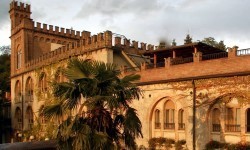
This 4-star hotel was a castle first constructed over 800 years ago. Now completely restored into a beautiful hotel and wellness center. Here you can enjoy steam, jacuzzi, pool and massage if ordered in advance.
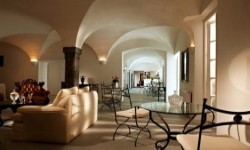
A privately owned 4-star hotel & spa in the heart of the medieval center's walking district puts you in the heart of activity near restaurants, cultural institutions and nightlife. Each room is luxuriously decorated in a contemporary and elegant style. Every detail is custom designed to create a relaxing and indulging experience.
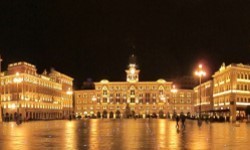
This 4-star hotel with a contemporary interior design set into an architecture of the 18th century, built on Roman ruins of the 1st century, offers world class hospitality in the Old Town. The location near the beautiful Piazza Unità, stretched out on the sea, is a stone’s throw from most points of interest in the city
*Please note: while these hotels are typically featured, we occasionally reserve other hotels of similar style and quality due to availability. Please call us if you have any questions about the exact hotels selected for any of our tours.
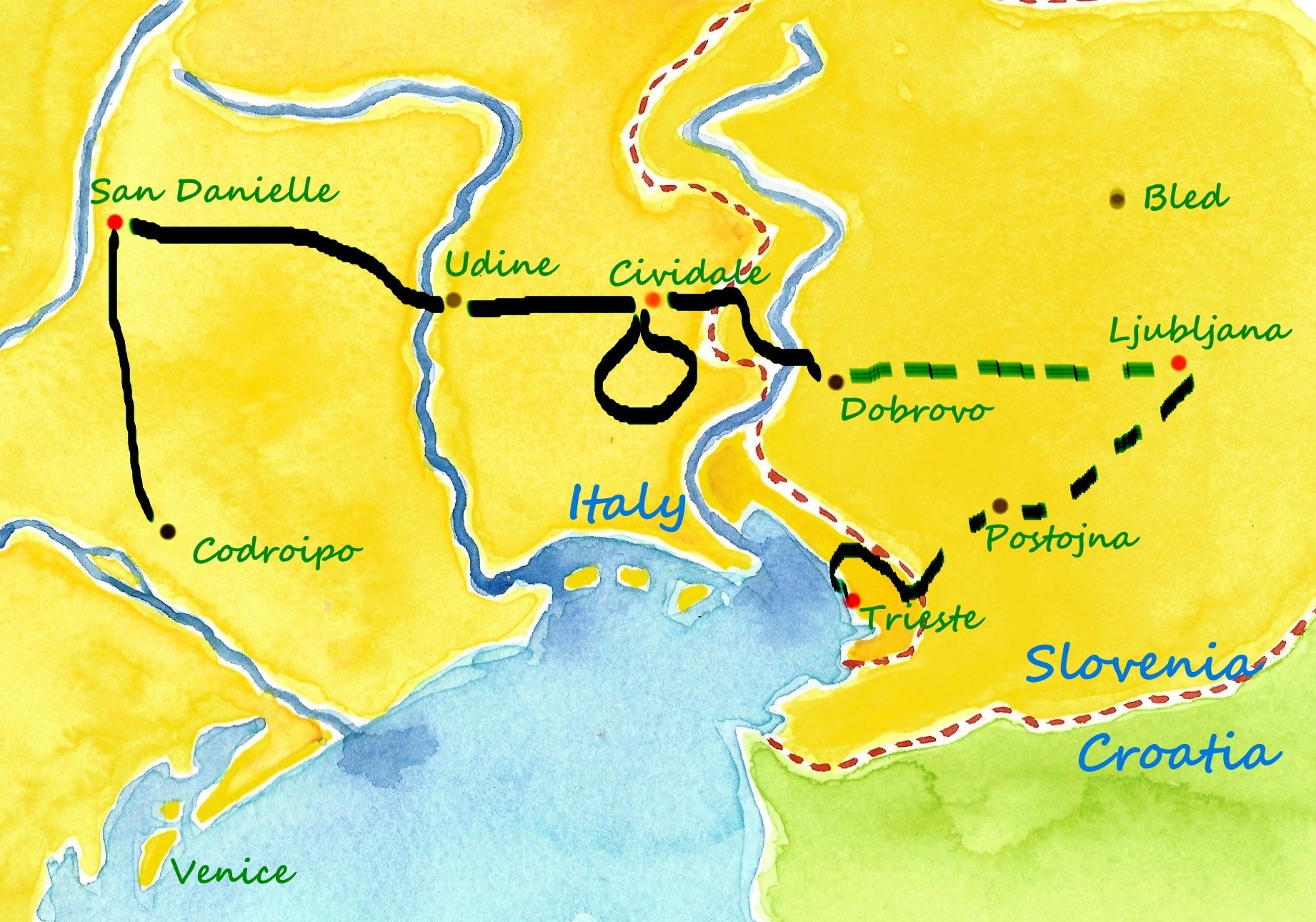
DAY-TO-DAY DISTANCES & HIGHLIGHTS
All the towns & lodgings we stay are highlights in themselve
Day 1: Ride 38 km / 25 miles mostly flat easy terrain w/ some short hills.Highlight Villa Manin, Castello d’Arcano, Prosciutto tasting & tour.
Day 2: Ride 42 km/27 miles mostly flat with several undulating stretches.Highlight: Castle laden countryside and several small villages to stop for gelato…
Day 3: Ride 40 km/ 26 miles then all flat through vineyards then one short climb.Highlights: winery tasting and Abbazia d’ Rosazzo visit.
Day 4: Ride 54km/35 miles or 23km/15miles - First option is 20km of a gradual climb building from 1% to less than 5% grade; then from border the 2nd option offers downhill and flat with some short climbs at end. Highlights: Slovenia border towns and train ride to the Ljubljana
Day 5: Ride 40 km/26 miles Optional ride to Bled . Undulating ride from the lake.
Highlights: City tour of capital and optional visit of Lake Bled
Day 6: Ride 30 to 50km/18-29miles of undulating terrain along Italy and Slovenian border then a long downhill into Trieste. Highlights: Visit Europe’s largest cave network & Castle Miramare visit
Day 7: Departure day…as pre-arranged.
KEEP IT PRIVATE ON AN EXISTING TOUR or CUSTOMIZE YOUR TRIP
If you have at least 6 participants we can keep it private on any of our sheduled tours or on an alternative date (subject to availability). For less than 6, prices may vary and for more than 12 discounts may apply.
To help us get started complete the form below. You can also call us M-Sat 9-5 PST (USA), or to the right, schedule a call or send us a message.
Sometimes a custom trip is participating in one of our exisitng trips on a private basis with a few alterations to trip length, activity level, or adding some side trips. Other times we get to work to create a unique itinerary specific to your groups desires or budget. We then use our expertise to organize a tour especially tailored to your vision.
The first thing we do is get to know you a little. We learn your interests and preferences, find out who’s going and why. Family, friends or associates? Birthday, reunion or corporate retreat? When you speak with our tour designer he/she will work together with you to design a trip that is sure to create great anticipation and excitement for all.